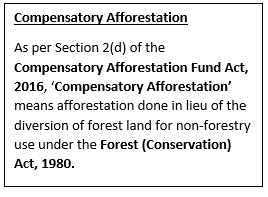SYLLABUS
GS-3: Environment Conservation
Prelims (GS-1): General issues on Environmental ecology, Bio-diversity & climate change
Context:
Recently, the Central Empowered Committee (CEC) reported that India achieved 85% of its compensatory afforestation target between 2019–20 and 2023–24.
Key highlights of the Report

- India raised 1,78,261 hectares of compensatory afforestation against a target of 2,09,297 hectares between 2019-20 and 2023-24
- The report highlights large variations in target achievement and fund utilisation across States and Union Territories.
- According to the report, Gujarat, Chandigarh, Mizoram and Madhya Pradesh recorded full achievement (100%) of their targets.
- In contrast, Meghalaya had one of the lowest coverages, achieving only 114.56 hectares against a target of 514.76 hectares or 22.3%.
- The report also reviewed the use of CAMPA funds during this period.
- National CAMPA approved Rs 38,516 crore for state annual plans between 2019-20 and 2023-24.
- States released Rs 29,311 crore to their forest departments, of which Rs 26,001 crore was utilised. This means only 67.5 per cent of the approved outlay was spent.
- Utilisation varied widely, with Manipur, Andhra Pradesh and Arunachal Pradesh utilising 100%, 100% and 97.8% of the funds released to them, respectively.
Compensatory Afforestation Fund Management and Planning Authority (CAMPA)
- CAMPA was first established by the Ministry of Environment & Forests on April 23, 2004, in compliance with a Supreme Court order in 2002.
- The Supreme Court’s order was based on the recommendations of the Central Empowered Committee (CEC).
- Later, in 2006, the Supreme Court directed the formation of an Ad-hoc CAMPA to oversee and manage the accumulating afforestation funds.
- The current institutional framework was formalised with the enactment of the Compensatory Afforestation Fund (CAF) Act, 2016, which provided a statutory basis for fund management through the National and State CAMPA authorities.
- The CAF Act and Rules came into effect on 30 September, 2018 enabling the creation of the compensatory afforestation fund as a special fund under the Public Account of India.
- These authorities are constituted in each state and union territory to manage and utilise funds for compensatory afforestation and related activities.
- There are 34 State and UT CAMPA (Compensatory Afforestation Fund Management and Planning Authority) Authorities in India.
Significance of CAMPA
- Dedicated Funds for Forest Restoration: It ensures that Net Present Value (NPV) funds and other compensatory levies are channelled exclusively for afforestation, biodiversity conservation and ecosystem restoration.
- Promotes Long-term Ecological Goals: It encourages holistic and sustained ecological restoration, including regeneration of degraded forests, removal of invasive species and soil and water conservation.
- Structured Planning and Oversight: It mandates Annual Plans of Operations and Perspective Plans for the systematic and effective use of funds. This helps in prioritising essential forestry and wildlife-related interventions.
- Central Monitoring and Guidance: The National CAMPA Authority issues guidelines and directions to state authorities to improve fund utilisation and target achievement.
Challanges of CAMPA
- Underutilisation of Funds: Despite large approvals, only 67.5% of the funds approved between 2019–2024 were utilised. This reflects inefficiencies and delays in fund disbursement and implementation.
- Administrative Delays: Issues such as late submission of annual plans, delayed release of funds, and absence of dedicated CAMPA offices hamper timely and effective implementation.
- Weak Monitoring of Outcomes: Survival rates of plantations and the actual ecological impact of the compensatory afforestation activities remain poorly monitored in several states.
- Lack of Transparency and Public Involvement: CAMPA processes often lack transparency and local community participation, which can undermine the ecological and social sustainability of the afforestation efforts.

